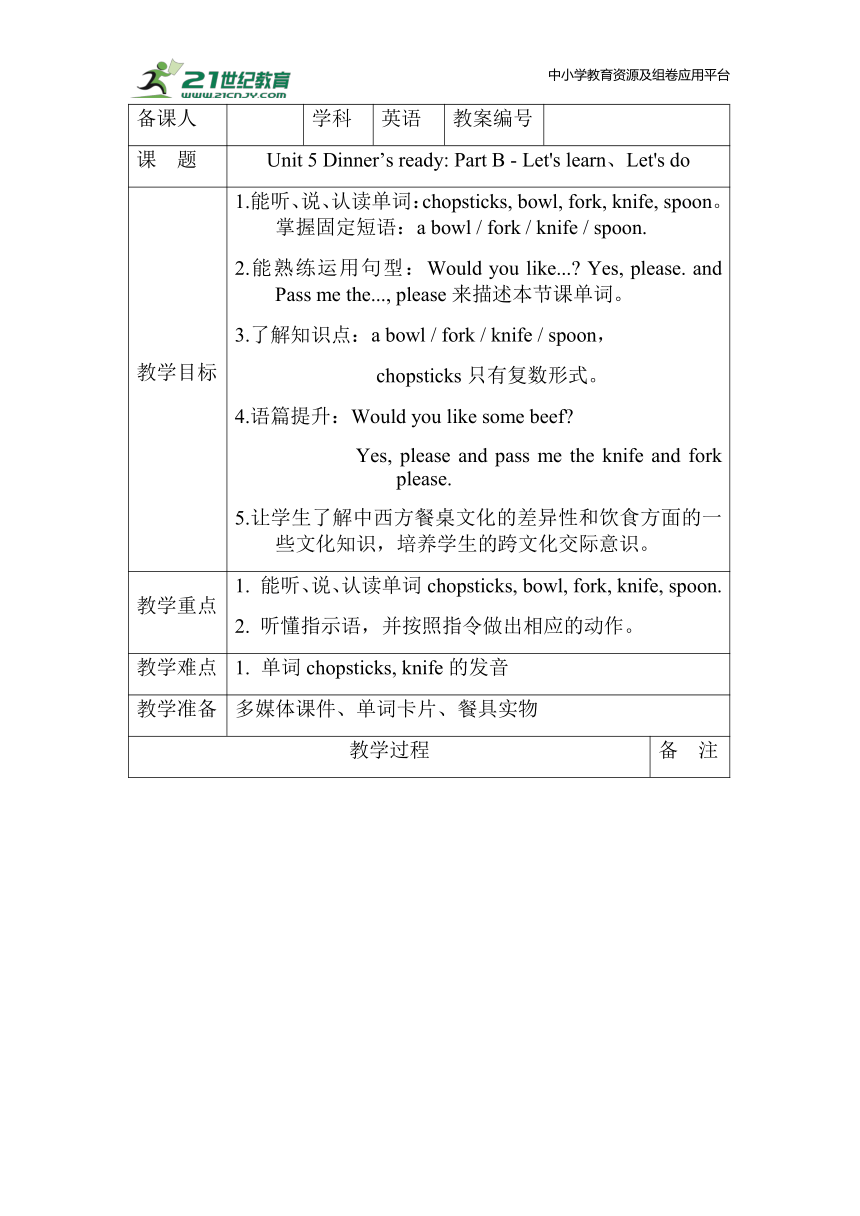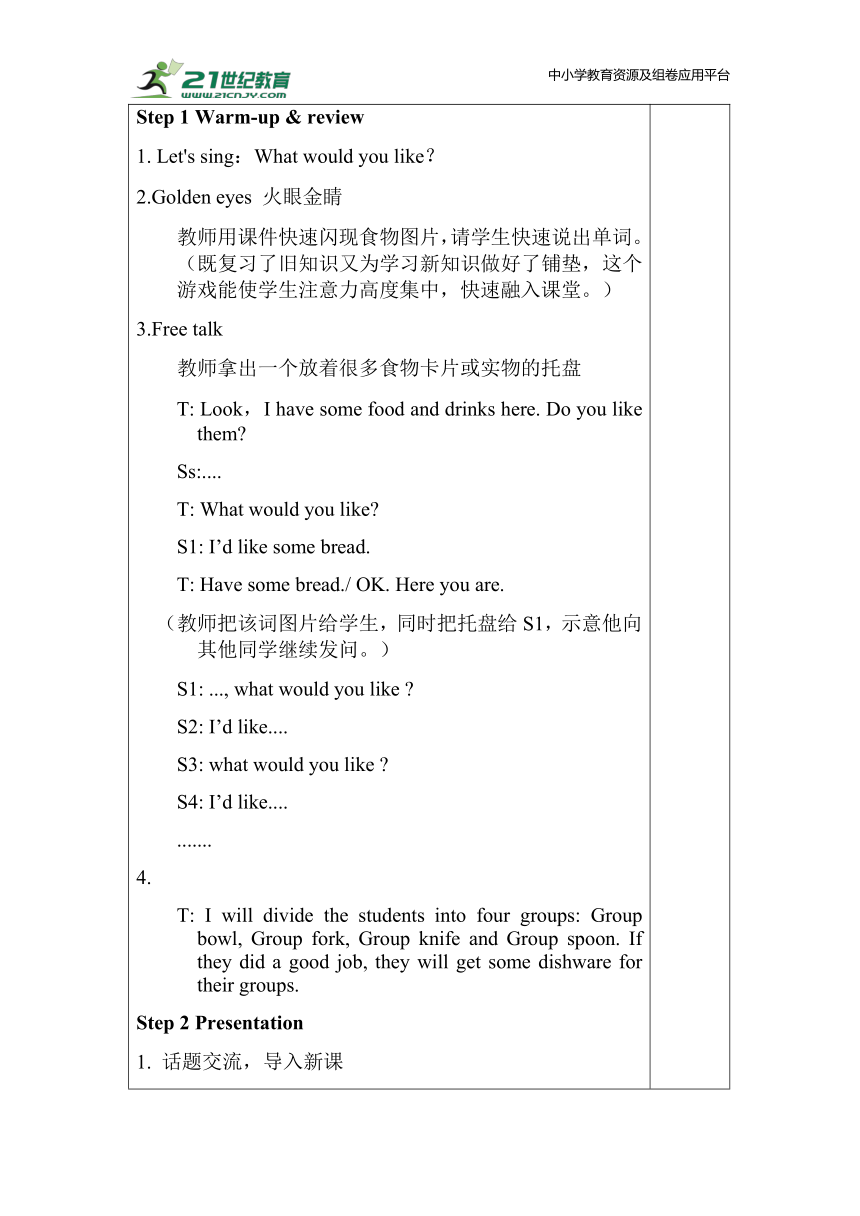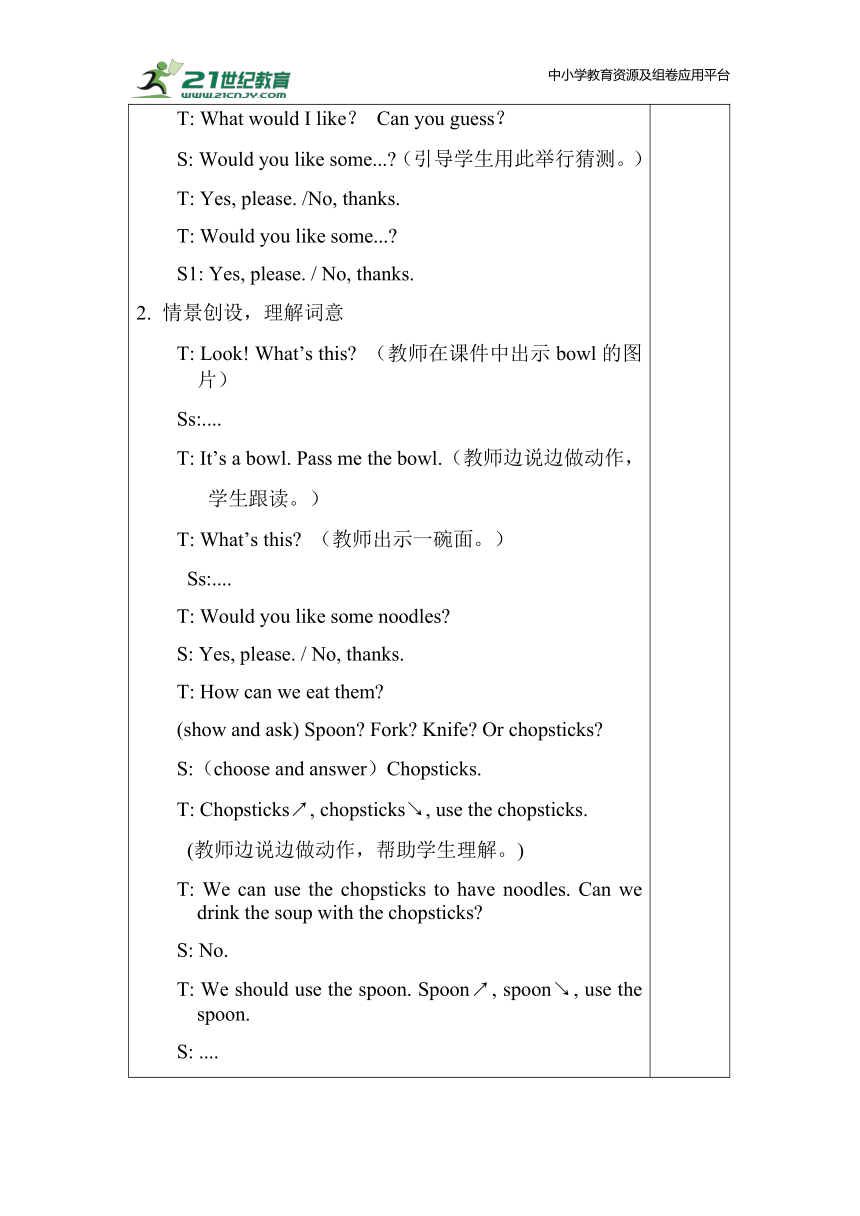Unit 5 Dinner's ready Part B Let's learn 表格式教案(含反思)
文档属性
| 名称 | Unit 5 Dinner's ready Part B Let's learn 表格式教案(含反思) |  | |
| 格式 | zip | ||
| 文件大小 | 135.9KB | ||
| 资源类型 | 试卷 | ||
| 版本资源 | 人教版(PEP) | ||
| 科目 | 英语 | ||
| 更新时间 | 2022-11-03 16:49:20 | ||
图片预览



文档简介
中小学教育资源及组卷应用平台
备课人 学科 英语 教案编号
课 题 Unit 5 Dinner’s ready: Part B - Let's learn、Let's do
教学目标 1.能听、说、认读单词:chopsticks, bowl, fork, knife, spoon。掌握固定短语:a bowl / fork / knife / spoon. 2.能熟练运用句型:Would you like... Yes, please. and Pass me the..., please来描述本节课单词。 3.了解知识点:a bowl / fork / knife / spoon, chopsticks只有复数形式。 4.语篇提升:Would you like some beef Yes, please and pass me the knife and fork please. 5.让学生了解中西方餐桌文化的差异性和饮食方面的一些文化知识,培养学生的跨文化交际意识。
教学重点 1. 能听、说、认读单词chopsticks, bowl, fork, knife, spoon. 2. 听懂指示语,并按照指令做出相应的动作。
教学难点 单词chopsticks, knife的发音
教学准备 多媒体课件、单词卡片、餐具实物
教学过程 备 注
Step 1 Warm-up & review 1. Let's sing:What would you like? 2.Golden eyes 火眼金睛 教师用课件快速闪现食物图片,请学生快速说出单词。(既复习了旧知识又为学习新知识做好了铺垫,这个游戏能使学生注意力高度集中,快速融入课堂。) 3.Free talk 教师拿出一个放着很多食物卡片或实物的托盘 T: Look,I have some food and drinks here. Do you like them Ss:.... T: What would you like S1: I’d like some bread. T: Have some bread./ OK. Here you are. (教师把该词图片给学生,同时把托盘给S1,示意他向其他同学继续发问。) S1: ..., what would you like S2: I’d like.... S3: what would you like S4: I’d like.... ....... 4. T: I will divide the students into four groups: Group bowl, Group fork, Group knife and Group spoon. If they did a good job, they will get some dishware for their groups. Step 2 Presentation 1. 话题交流,导入新课 T: What would I like? Can you guess? S: Would you like some... (引导学生用此举行猜测。) T: Yes, please. /No, thanks. T: Would you like some... S1: Yes, please. / No, thanks. 情景创设,理解词意 T: Look! What’s this (教师在课件中出示bowl的图片) Ss:.... T: It’s a bowl. Pass me the bowl.(教师边说边做动作, 学生跟读。) T: What’s this (教师出示一碗面。) Ss:.... T: Would you like some noodles S: Yes, please. / No, thanks. T: How can we eat them (show and ask) Spoon Fork Knife Or chopsticks S:(choose and answer)Chopsticks. T: Chopsticks↗, chopsticks↘, use the chopsticks. (教师边说边做动作,帮助学生理解。) T: We can use the chopsticks to have noodles. Can we drink the soup with the chopsticks S: No. T: We should use the spoon. Spoon↗, spoon↘, use the spoon. S: .... T: Look! Here’s some beef. Is it delicious Would you like some beef S: Yes, please. T: But how can we eat it S: Use the knife and fork. T: Knife↗, knife↘, cut with the knife. (教师边说边做动作,学生跟读,注意强调字母i的发音。) T: Fork↗, fork↘, use the fork. (教师示范,学生做动作跟读) T: I’d like some beef. Pass me the knife and fork, please. (教师示范,学生跟读) 引导学生说: Ss: I’d like some noodles. Pass me the chopsticks. 3.句中学习,领读单词 A. 巩固单词记忆,反复领读词卡。教师领读,男生女生读,分排、分行、分组读,“小老师”领读,大小声法等多种方式相结合,让学生在角色转换和反复训练中加深对词汇的感知。 B. 学生对单词有了初步了解和记忆后,将单词融入句子和具体情景中,进行语言交际训练。 T: Would you like some noodles S: Yes, please, and pass me the chopsticks please. / No, thanks. 4.版式呈现,视听正音 听一听,练一练 请学生先听录音,再请学生跟录音模仿单词和句子,看谁说得最好,为下环节的联系做准备。 Step 3 Practice 1. Listen, repeat and imitate. 跟读录音,强化模仿。 2.Let's do. 3.What’s missing 课件呈现餐具单词,每次消失一个,请学生快速说出“What’s missing ” Step 4 Extension 小调查 将学生分为四人一组,组内互相询问对食物的喜好,并完成表格。 S1:Would you like some... S2: Yes, please, and pass me the ...,please./ No, thanks. 2. 向学生介绍中西方餐桌文化的差异性和饮食方面的一些文化知识,培养学生的跨文化交际意识。
板书设计: Would you like some noodles Yes, please. / No, thanks. Pass me the bowl / fork / knife / spoon/ chopsticks,please. 作业布置: 1)听并模仿教材录音,并尝试复述。 2) 参考如下对话形式编对话 Would you like.., Yes,please, and pass me the...,please.
教学反思: 本课时的教学目标是学习与餐具相关的单词,教材内容是通过John在吴一凡家做客就餐的情景图呈现了单词的词性和意义。通过本课时的教学使学生了解中西方饮食文化中餐具使用的差异,对如何使用刀叉的基本知识有所了解,并能够体会the所表达的特指含义。在本课时的教学设计中,加入了TPR的活动,训练学生手脑眼的配合,强化单词的音义匹配,并提高课堂词汇学生的趣味性。要求学生能听懂指令,并根据指令做出正确的动作。 在实际的教学过程中,我给出更多的时间给学生思考和说英语的机会,一步步地引导学生从新单词的学习到新句型的学习。新巨型的学习中,先以已经学过的类似句型进行导入。教学过程的尾声处的拓展训练,课后的反应比较好,大多数学生都可以掌握,并且也能够了解到一些教材中没有的关于中西方餐饮文化的差异。
备课人 学科 英语 教案编号
课 题 Unit 5 Dinner’s ready: Part B - Let's learn、Let's do
教学目标 1.能听、说、认读单词:chopsticks, bowl, fork, knife, spoon。掌握固定短语:a bowl / fork / knife / spoon. 2.能熟练运用句型:Would you like... Yes, please. and Pass me the..., please来描述本节课单词。 3.了解知识点:a bowl / fork / knife / spoon, chopsticks只有复数形式。 4.语篇提升:Would you like some beef Yes, please and pass me the knife and fork please. 5.让学生了解中西方餐桌文化的差异性和饮食方面的一些文化知识,培养学生的跨文化交际意识。
教学重点 1. 能听、说、认读单词chopsticks, bowl, fork, knife, spoon. 2. 听懂指示语,并按照指令做出相应的动作。
教学难点 单词chopsticks, knife的发音
教学准备 多媒体课件、单词卡片、餐具实物
教学过程 备 注
Step 1 Warm-up & review 1. Let's sing:What would you like? 2.Golden eyes 火眼金睛 教师用课件快速闪现食物图片,请学生快速说出单词。(既复习了旧知识又为学习新知识做好了铺垫,这个游戏能使学生注意力高度集中,快速融入课堂。) 3.Free talk 教师拿出一个放着很多食物卡片或实物的托盘 T: Look,I have some food and drinks here. Do you like them Ss:.... T: What would you like S1: I’d like some bread. T: Have some bread./ OK. Here you are. (教师把该词图片给学生,同时把托盘给S1,示意他向其他同学继续发问。) S1: ..., what would you like S2: I’d like.... S3: what would you like S4: I’d like.... ....... 4. T: I will divide the students into four groups: Group bowl, Group fork, Group knife and Group spoon. If they did a good job, they will get some dishware for their groups. Step 2 Presentation 1. 话题交流,导入新课 T: What would I like? Can you guess? S: Would you like some... (引导学生用此举行猜测。) T: Yes, please. /No, thanks. T: Would you like some... S1: Yes, please. / No, thanks. 情景创设,理解词意 T: Look! What’s this (教师在课件中出示bowl的图片) Ss:.... T: It’s a bowl. Pass me the bowl.(教师边说边做动作, 学生跟读。) T: What’s this (教师出示一碗面。) Ss:.... T: Would you like some noodles S: Yes, please. / No, thanks. T: How can we eat them (show and ask) Spoon Fork Knife Or chopsticks S:(choose and answer)Chopsticks. T: Chopsticks↗, chopsticks↘, use the chopsticks. (教师边说边做动作,帮助学生理解。) T: We can use the chopsticks to have noodles. Can we drink the soup with the chopsticks S: No. T: We should use the spoon. Spoon↗, spoon↘, use the spoon. S: .... T: Look! Here’s some beef. Is it delicious Would you like some beef S: Yes, please. T: But how can we eat it S: Use the knife and fork. T: Knife↗, knife↘, cut with the knife. (教师边说边做动作,学生跟读,注意强调字母i的发音。) T: Fork↗, fork↘, use the fork. (教师示范,学生做动作跟读) T: I’d like some beef. Pass me the knife and fork, please. (教师示范,学生跟读) 引导学生说: Ss: I’d like some noodles. Pass me the chopsticks. 3.句中学习,领读单词 A. 巩固单词记忆,反复领读词卡。教师领读,男生女生读,分排、分行、分组读,“小老师”领读,大小声法等多种方式相结合,让学生在角色转换和反复训练中加深对词汇的感知。 B. 学生对单词有了初步了解和记忆后,将单词融入句子和具体情景中,进行语言交际训练。 T: Would you like some noodles S: Yes, please, and pass me the chopsticks please. / No, thanks. 4.版式呈现,视听正音 听一听,练一练 请学生先听录音,再请学生跟录音模仿单词和句子,看谁说得最好,为下环节的联系做准备。 Step 3 Practice 1. Listen, repeat and imitate. 跟读录音,强化模仿。 2.Let's do. 3.What’s missing 课件呈现餐具单词,每次消失一个,请学生快速说出“What’s missing ” Step 4 Extension 小调查 将学生分为四人一组,组内互相询问对食物的喜好,并完成表格。 S1:Would you like some... S2: Yes, please, and pass me the ...,please./ No, thanks. 2. 向学生介绍中西方餐桌文化的差异性和饮食方面的一些文化知识,培养学生的跨文化交际意识。
板书设计: Would you like some noodles Yes, please. / No, thanks. Pass me the bowl / fork / knife / spoon/ chopsticks,please. 作业布置: 1)听并模仿教材录音,并尝试复述。 2) 参考如下对话形式编对话 Would you like.., Yes,please, and pass me the...,please.
教学反思: 本课时的教学目标是学习与餐具相关的单词,教材内容是通过John在吴一凡家做客就餐的情景图呈现了单词的词性和意义。通过本课时的教学使学生了解中西方饮食文化中餐具使用的差异,对如何使用刀叉的基本知识有所了解,并能够体会the所表达的特指含义。在本课时的教学设计中,加入了TPR的活动,训练学生手脑眼的配合,强化单词的音义匹配,并提高课堂词汇学生的趣味性。要求学生能听懂指令,并根据指令做出正确的动作。 在实际的教学过程中,我给出更多的时间给学生思考和说英语的机会,一步步地引导学生从新单词的学习到新句型的学习。新巨型的学习中,先以已经学过的类似句型进行导入。教学过程的尾声处的拓展训练,课后的反应比较好,大多数学生都可以掌握,并且也能够了解到一些教材中没有的关于中西方餐饮文化的差异。
